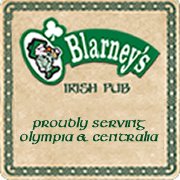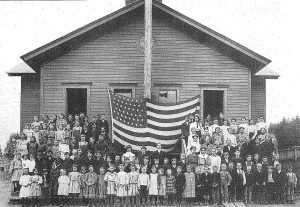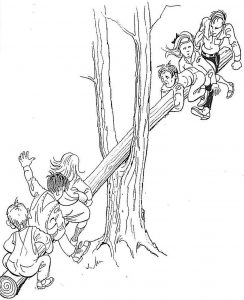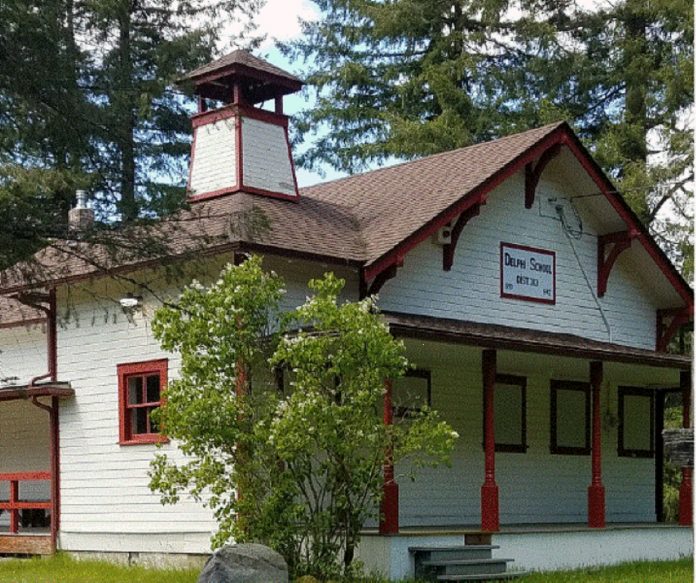Everyone started life as children. That includes grandparents like me. I fondly remember my grandpa, Bill Trosper, telling me that he was 10 years old when he arrived in Thurston County from Kansas in 1892. He added that the countryside south of old Tumwater at that time was so full of old-growth timber that a person could walk from what is today Capitol Boulevard all the way to Black Lake on fallen logs without having to touch the ground. He was known to exaggerate at times. Thurston County History sounds different when looked through the eyes of the young.
 He attended a one-room schoolhouse through eighth grade called the Belmore School. As a teenager he worked for Uncle Jesse Ferguson, one of Tumwater’s founders, plowing a field with large work horses. Today, that site is the Mills and Mills Cemetery off Littlerock Road, which means that he is buried in the very field he once plowed.
He attended a one-room schoolhouse through eighth grade called the Belmore School. As a teenager he worked for Uncle Jesse Ferguson, one of Tumwater’s founders, plowing a field with large work horses. Today, that site is the Mills and Mills Cemetery off Littlerock Road, which means that he is buried in the very field he once plowed.
Ada Sprague Mowell shared precious memories of her Tumwater childhood in 1800s Tumwater. “While pioneer life was full of hardships for the elders,” she says, “it was full of joy for the youngsters. Looking back over our childhood, it seems like a long day of playtime. We had wonderful adventures in the woods about the place. We built houses of round sticks of several stories for our dolls, which often were sticks themselves, or at best ‘rag dolls.’ My first China doll was given me by a neighbor, Mrs. Hara, whose little girl had died. It was a precious possession, but never so dearly loved as my rag babies.”
Her memory of her first attendance at the schoolhouse on Tumwater Hill was one of being in deadly fear of the teacher who taught with “the rod” ever in his hand. At that time the school was moved into the Tumwater Literary Association building. “School was held in the lower floor,” she recalls. “Once when some of the older boys planned to eject the teacher, during the scuffle which followed my sister, Etta…put all the children out of the window and then clambered after us, whither most of the school followed. School in those days never lacked for excitement.”

Photo courtesy: Tumwater School District
Another of my favorite stories came from the Tumwater school on Second Avenue in the 1880s. “A frame building about 50 feet square,” George Shattuck says of the building “Handmade desks. Heated by a wood stove. One teacher, named Conine, a very rough and tough individual. Keeping discipline by throwing an eraser — a block of wood with the sheep skin tacked to it — at the unruly boys. Usually saying ‘stand up on your pins and take your hands out of your pants.’ He would line up the larger boys and switch them all at the same time. He had to bluff the boys into minding as they were mostly larger than he was. Later the teachers were old maids from Boston. Coming west with an over-sized grudge against the world and in particular the male race.”
Robert Chamberlain attended a one-room schoolhouse in the 1930s located south of Tumwater on Old Highway 99. It was called the Plumb Station School, taught by Miss Grace Michaels. He shares that the only athletic equipment was one baseball and a bat. They invented games, played marbles, work-up baseball, King of the Hill and even made their own teeter-totter by placing a peeled log in the notch of a tree. It was dismantled after many cuts and bruises and a broken wrist.

The East Olympia School was known as the Chambers Prairie School until 1937. It had two teachers, separate boys’ and girls’ outhouses and a dirt playground with a set of swings. The library was a visiting bookmobile. Some of the children got into mischief with pranks that were a little rougher in those years, such as tipping over outhouses or letting dogs loose to fight. The punishment for bad behavior was rougher too, consisting mostly of corporal punishment in the form of paddles, belts or hickory sticks. Swats were a common and acceptable punishment.
In 1987 the students of the East Olympia Elementary Enrichment Class wrote about a story they found from 1921: “…the eighth grade boys put a buggy on the roof of the school for a Halloween joke. Two of the boys who put the buggy on the roof got caught when they were coming down from the roof. The boys were taken home to their parents and had to tell who else put the buggy on the roof. So the other boys didn’t get caught until the next day.”
Yes, the best memories are childhood memories. Just ask your grandparents.


















































